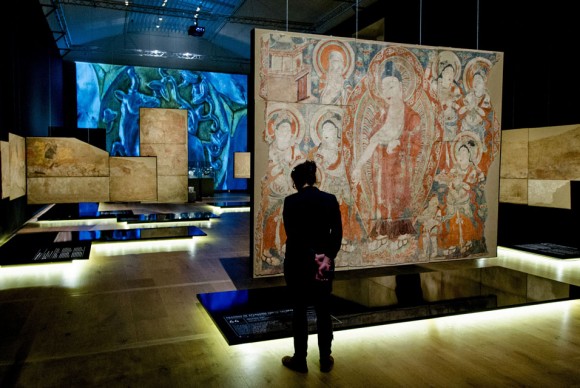Expedition Silk Road: Exhibition in Amsterdam offers a glimpse of long-lost civilizations
February 28, 2014 by All Art News
Filed under Antiques & Archaeology
AMSTERDAM.- From 1 March 2014 onwards, the Hermitage Amsterdam will offer visitors a glimpse of the long-lost civilizations along the legendary Silk Road. Until 5 September 2014, the exhibition Expedition Silk Road will present treasures from the Hermitage: 250 exceptionally beautiful objects, such as murals, Buddhas, precious silks, silver, glass, gold, and terracotta, excavated by Russian expeditions in the nineteenth and twentieth centuries. Visitors will follow in the footsteps of the explorers who mapped the routes of kings and merchants, and of the Buddhist monks who went before them. Like the caravans that crossed this inhospitable region ages ago, passing through kingdoms, monasteries, and oases, visitors will travel the trade routes from west to east or east to west, and discover spectacular ancient treasures along the way. Among the many highlights will be a more than nine-metre-long mural of a deity in battle with predators from the royal palace in Varakhsha (7th–8th century, present-day Uzbekistan). This prized work of art has never left the Hermitage before, but after its restoration, made possible by crowdfunding by the Friends of the Hermitage, it will be on display in Amsterdam for more than six months.
The Silk Road predates the Christian era, and until the fifteenth century, it was the world’s largest trade network and a source of unprecedented cultural interchange. It ran from China to the Mediterranean. The Silk Road was not a single path but a network of trade routes spanning a distance of 7,000 kilometres. It crossed the inhospitable and sparsely populated region of Central Asia, with its vast deserts and impassable mountain ranges, and connected great civilizations such as India, Persia, China, and the Roman Empire. The fertile oases in this enormous region, and the kingdoms that emerged there, played a crucial and welcome role as way stations and marketplaces.

A visitor looks at a mural during the press viewing of the exhibition “Expedition Silk Road” at the Hermitage museum in Amsterdam, Netherlands, on February 27, 2014. From 1 March 2014 onwards, the Hermitage Amsterdam will offer visitors a glimpse of the long-lost civilizations along the legendary Silk Road. Through March 1 – September 5, 2014, the exhibition “Expedition Silk Road” will present 250 exceptionally beautiful objects, such as murals, sculpture, precious silks, silver, glass, gold, and terracotta, excavated by Russian expeditions in the 19th and 20th centuries. AFP PHOTO / ANP / ROBIN VAN LONKHUIJSEN.
A thousand camels
The more than 250 treasures in the exhibition come from thirteen archaeological sites on the Silk Road, associated with a variety of kingdoms and places. Along the trade routes, an unprecedented interchange of goods and ideas took place, as shown by the monumental murals excavated all along the Silk Road. Buddhism was the earliest cultural phenomenon to spread by means of these roads, borne from India towards China by wandering monks. Centuries later, Islam began moving eastward along the same paths, replacing Buddhism in many places. Christianity and Judaism were also disseminated along the Silk Road. For instance, an incense burner with Christian iconography and a ring showing Daniel in the lion’s den have been found deep in Central Asia.
The largest-scale interchange was the trade in goods. Caravans with as many as a thousand camels, horses, oxen, and donkeys traversed the region from east to west, from north to south, and back again. Silk was one of the first trade items, and for a while it was even a means of payment. But many other products travelled the Silk Road. Besides silk, the products from China included lacquer, ceramics, and porcelain. From the Mediterranean region in the west came goods such as glass and textiles. Fur came from Siberia in the north, while topaz, emeralds, perfumes, henna, and exotic animals were brought from India in the south. Central Asian cultures, such as the vanished kingdom of Sogdia, produced exquisitely wrought silver for trade.
The expeditions and the collection
The cultures of the Silk Road were not rediscovered until the late nineteenth century, when Russia, Great Britain, Germany, and Japan organized the first expeditions. Dozens of expeditions headed by Russian archaeologists set off for Mongolia, western China, and the Central Asian republics. On many sites, they uncovered treasures spanning many centuries, from long before Christ to the Middle Ages. In the Hermitage in St. Petersburg, these were presented as ancient treasures of the Soviet Union with its many peoples. The objects in this exhibition have been drawn from the vast collection of the Oriental Department of the Hermitage. Finds from thirteen archaeological sites form the basis for the exhibition, painting a vivid picture of the diversity and cultural influences along the Silk Road.
